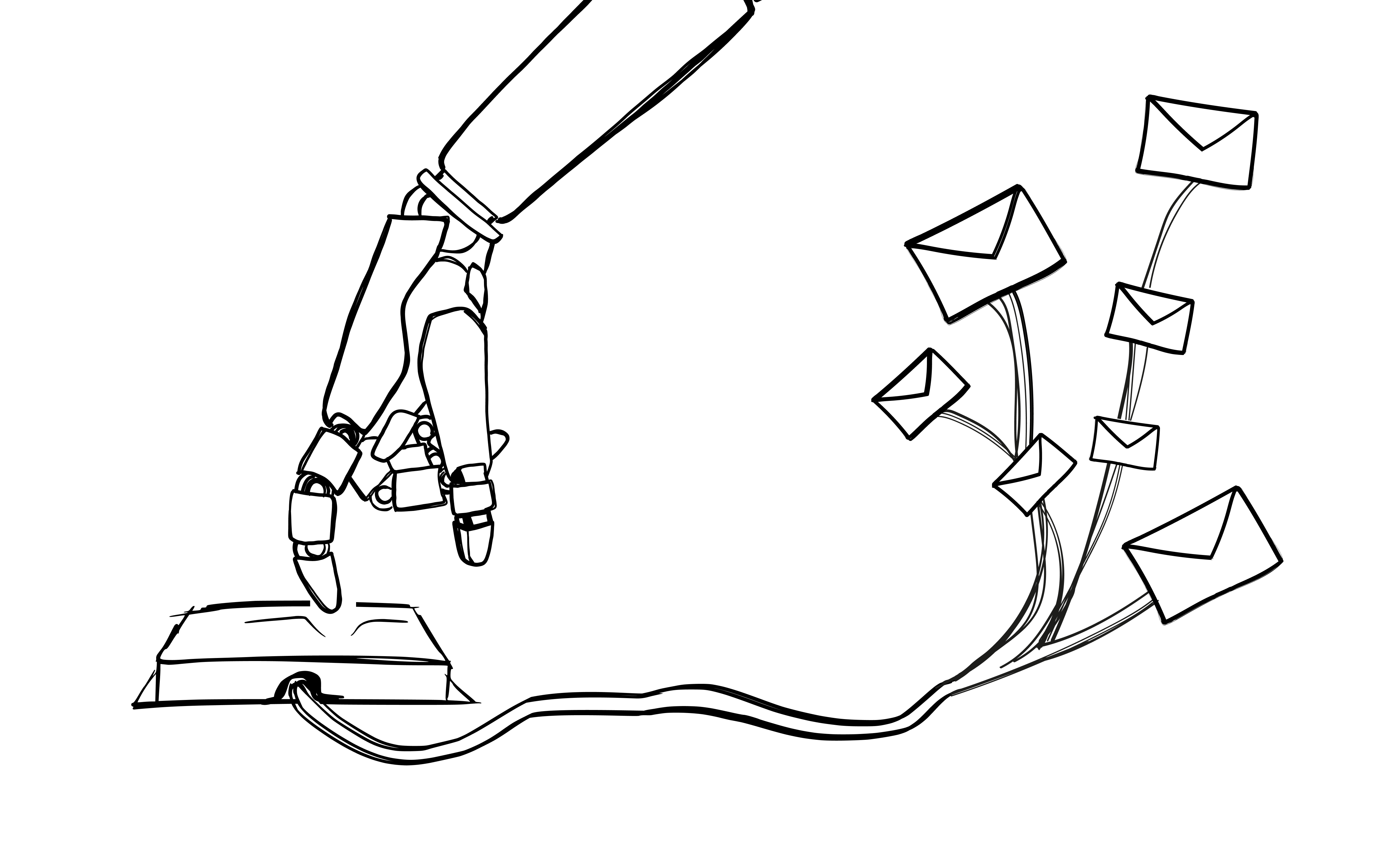Note – All the examples used in this post were taken from ChatGPT 3.5. You may get similar but different results with other platforms but the basic ideas we discuss here are relevant to every AI content tool.
In the previous post in this series, we looked at how the use of cold email frameworks can help you to make better, more compelling and more effective communications for engaging prospects.
This time, we’re focusing on prompts, or the input you give as guidance for AI text generation tools, like Chat GPT.
Prompts are very important when creating AI-generated content because it tells the AI tool everything about the kind of content you want to produce. The more information you provide in your prompt, the more aligned the final product will be with what you have in mind.
Let’s look at the many ways you can use your prompt to influence the shape, form and content of your cold emails.
Mastering the power of the prompt
AI text generators don’t ask much from you. They will take whatever you enter — your prompt — and run with it.
That makes things simple but it also means that every word matters.
Just as a recipe for a favorite dish will produce similar but different results if you add or change the ingredients, the results you get from AI can vary depending on the “ingredients” that you give it.
Let’s start by looking at some of the basic, most important ways the prompt you provide directly impacts the results you get. Before a single word appears on the screen in response to your input, these are some of the ways your prompt can influence what kind of content your AI tool will create.
Value proposition
- Put the focus on a particular benefit or feature of a product or service
- Highlight how your offer addresses a specific pain point or challenge that the recipient is dealing with
- Show how your offer is somehow better than other options available
Purpose and goal
- Make the goal of the message clear, whether it’s a sales pitch, proposal for collaboration, clicking something in the email or anything else
- Be sure all parts of the message are working toward the same goal — making a sale, setting up a meeting, getting feedback, etc.
- Make it easy for the recipient to understand what he or she is supposed to do in response to receiving the message
Audience description
- Adjust your message to the level of knowledge about the subject that your audience has
- Use (or don’t use) industry jargon and buzzwords depending on who’s reading your message
- Choose different approaches depending on how familiar the recipients are with you — is this a first contact or something further down the funnel?
Pain points and challenges
- Specify the recipient’s pain points, challenges or goals that you’re addressing in your email
- Show how your solution addresses those concerns better than other options
- Focus on how much time, money or other resources the recipient is losing by not solving this pain point immediately
General tone and style
- Choose from casual, formal, urgent, friendly, humorous, simple, etc.
- Match the tone and style to the purpose of the email — mismatches will be confusing to recipients and make the message ineffective
- Don’t take chances with unconventional styles unless it matches your brand voice, etc.
Length and formatting
- Specify short, medium or long lengths for your email
- Use formatting like bullet points, numbered lists, etc. to make your message more readable
- Adapt the length of your emails to fit the place in the funnel where the recipient is — with shorter initial messaging and longer, more detailed emails later
Handling objections
- Use prompts to create emails specifically designed to answer common objections to a sales proposition
- Include details that answer and correspond to each common objection
- Be sure the length, formatting and tone allow for the complete examination of objections
Call to action (CTA)
- Use your prompt to change the placement of the CTA in your email, its formatting, tone and more
- Make your entire message about directing attention to the CTA or leave the focus on your text
- Use multiple CTAs since it’s one of the best, most useful kinds of A/B tests to run
Smaller, more subtle ways to use your prompt
Now let’s change the focus away from the big-picture ways your prompt determines the overall shape and form of your cold emails to some smaller details that we can illustrate.
Sometimes the cold email you compose is 95% of the way there but it’s just missing something. The addition of one more small element, a slight change in the tone of voice, some statistics or another creative addition — these can all be the difference between “good” and “great”.
That’s why it’s important to remember that you can use your prompt to make slight changes in what is already a pretty good text. Let’s look at how making these small changes or additions to your prompt can result in big jumps in the quality of your cold emails.
Rewording
Sometimes all you need is to literally rearrange the words and ideas on the page for a better, more easily readable message.
Compare these two different versions of the same email. For the first, I wrote “Create an invitation for an IT recruitment webinar” and the second was produced after telling AI to “reword” the first one:

A perfectly acceptable text for a cold email, very straightforward. To me, this sounds like AI because it uses so many standard bits and pieces of content that always appear in such invitations, like “Join us on”, “Gain valuable insights”, “Don’t miss this opportunity” and “We look forward”.
Now let’s ask AI just to reword the same email:

Not a world of difference between them but the second one just feels better. A little more “human” and less stiff. It definitely sounds like it came from a person and not a machine.
It could be a good habit to check a “reword” version of every email just to compare and see if you can get something just a little better.
Change tone
This is a very useful one and the results you get may surprise you. Obviously, you want all of your emails to be a balance between professional, friendly and informative. Playing with the exact proportions can be just what you need.
Let’s stay with the same example above from “Rewording” about an IT webinar. I asked AI to reword it with more urgency and here’s what I got:

I think it’s clearly better than the original — more friendly while also creating a sense of urgency among recipients and still keeping the core of the message clear. A clear win for “change tone”.
Add examples / case studies / success stories
Cold emails in particular can often benefit from a bit of social proof. Add an example, case study or success story to briefly illustrate your message.
Here’s my original IT webinar email, but upgraded with some additional information that helps to paint a mental picture for the recipient:
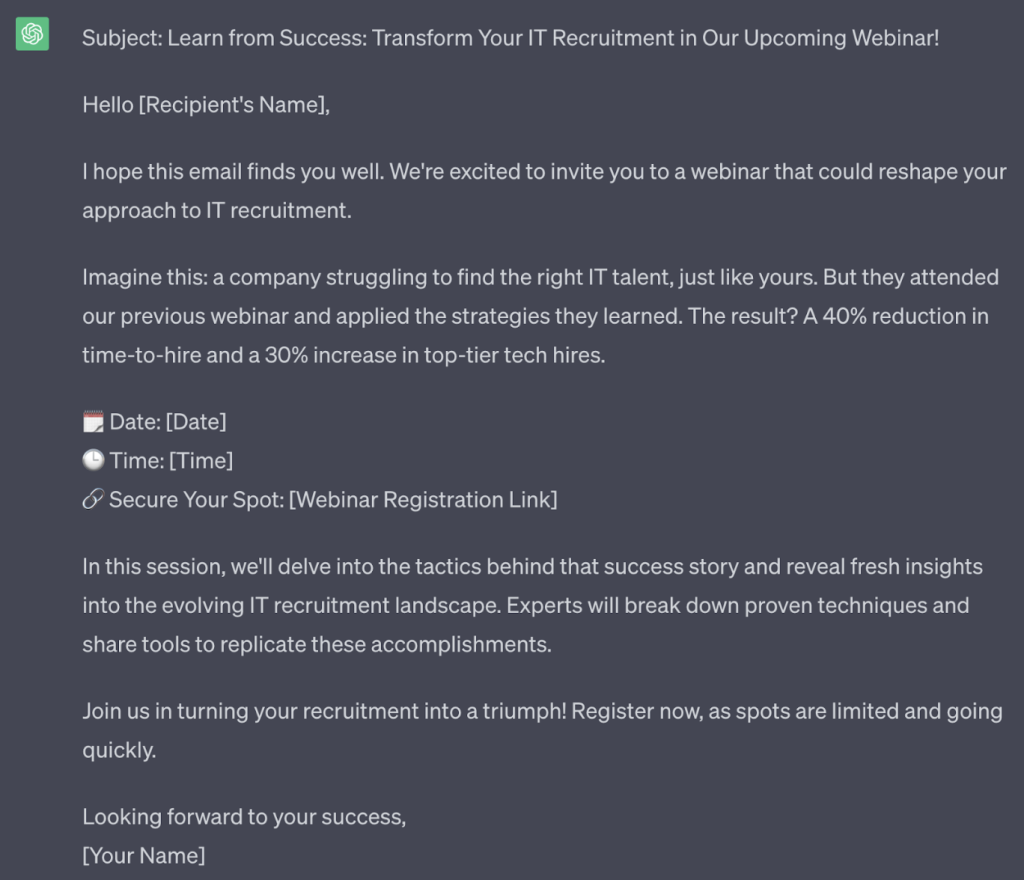
In this case, I think the addition is that little extra “something” that makes the whole message more effective. Adding examples and mini case studies like this makes it easier for the prospect to imagine that they can get the same results, which moves them a step closer to engaging with you.
Highlight benefits
This is something you should be doing anyway but if you want to leave it to AI, you can. Again, I took my original message and added “add benefits”. Here’s what I got:
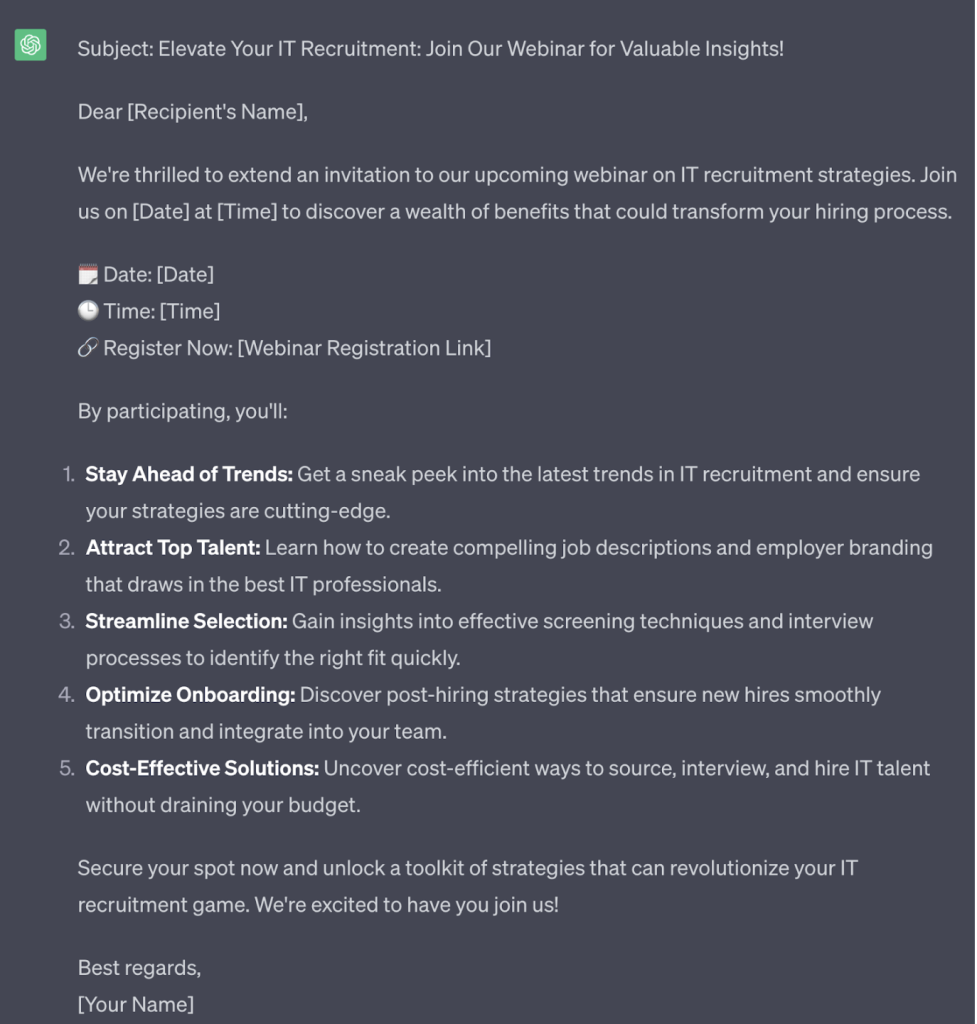
In addition to adding a numbered list of benefits, it reworded a couple of things as well. The result is definitely more compelling than what I started with. This is quite similar to the previous point about adding examples, case studies and success stories — you help the recipient visualize what they have to gain by getting interested in your message.
Address objections
Every marketer knows that you have to address objections at some point so why not build it right into your cold outreach? Here’s what I got when I added “address objections” to the prompt for my original email:
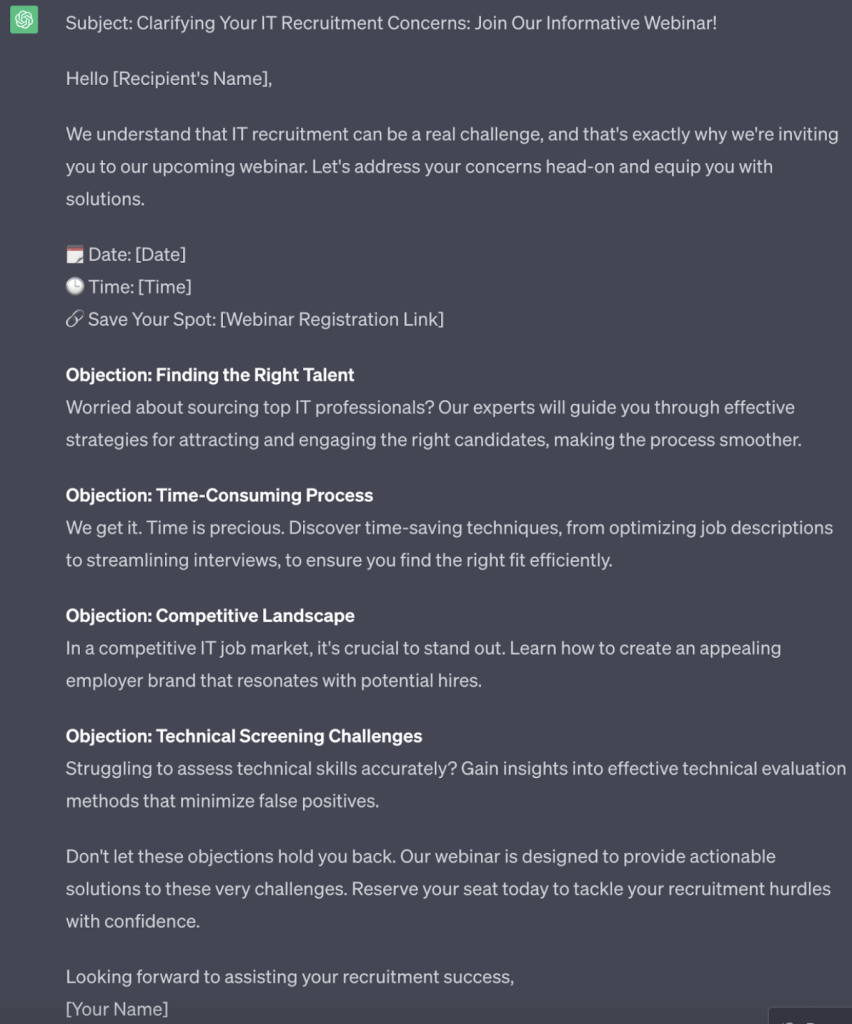
I think it’s odd that AI decided to label the objections as “Objections” right there in the email but I would delete that. The rest of it is fine and, once again, the result is something better than what I started with. How can you object to joining my webinar after reading this?
Use analogies or metaphors
Here’s one that might not be relevant to every situation but works well when it fits. Adding an analogy or metaphor can be just the creative touch you need to make a “meh” text more interesting.
Look at what happened when I took my original email and added “use analogies or metaphors”:
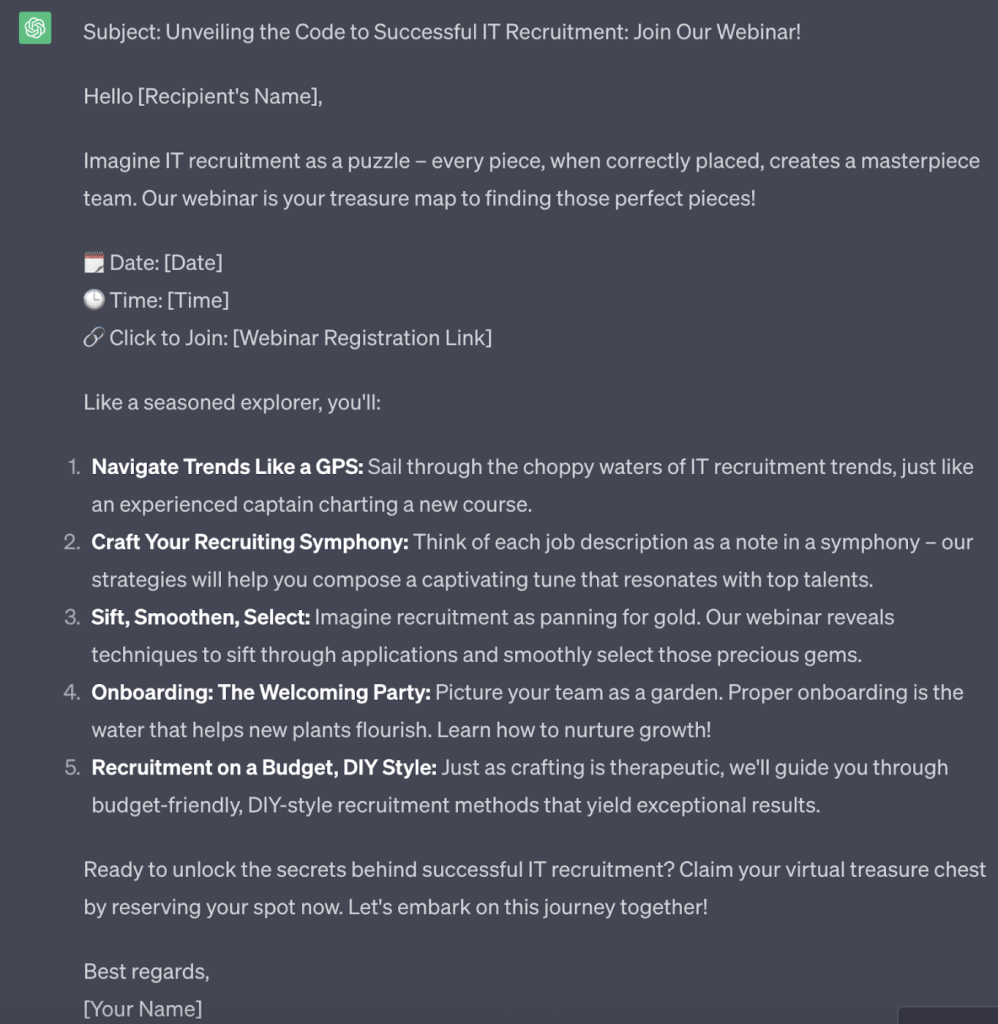
IT recruitment as a puzzle? A treasure map for finding missing pieces? Navigating the waters of IT? Why not? Isn’t it better than “Join us for this webinar…”?
This is a great example of how just a small tweak in your prompt (use analogies or metaphors) can turn a cold email from weak to wow!
Add statistics or data
Nothing makes you sound more sure of what you’re talking about than numbers, percentages and data. Add an element of authority to your message and, even better, let AI do the searching for it. Here’s what I got when I told AI to “add statistics or data” to my original message:
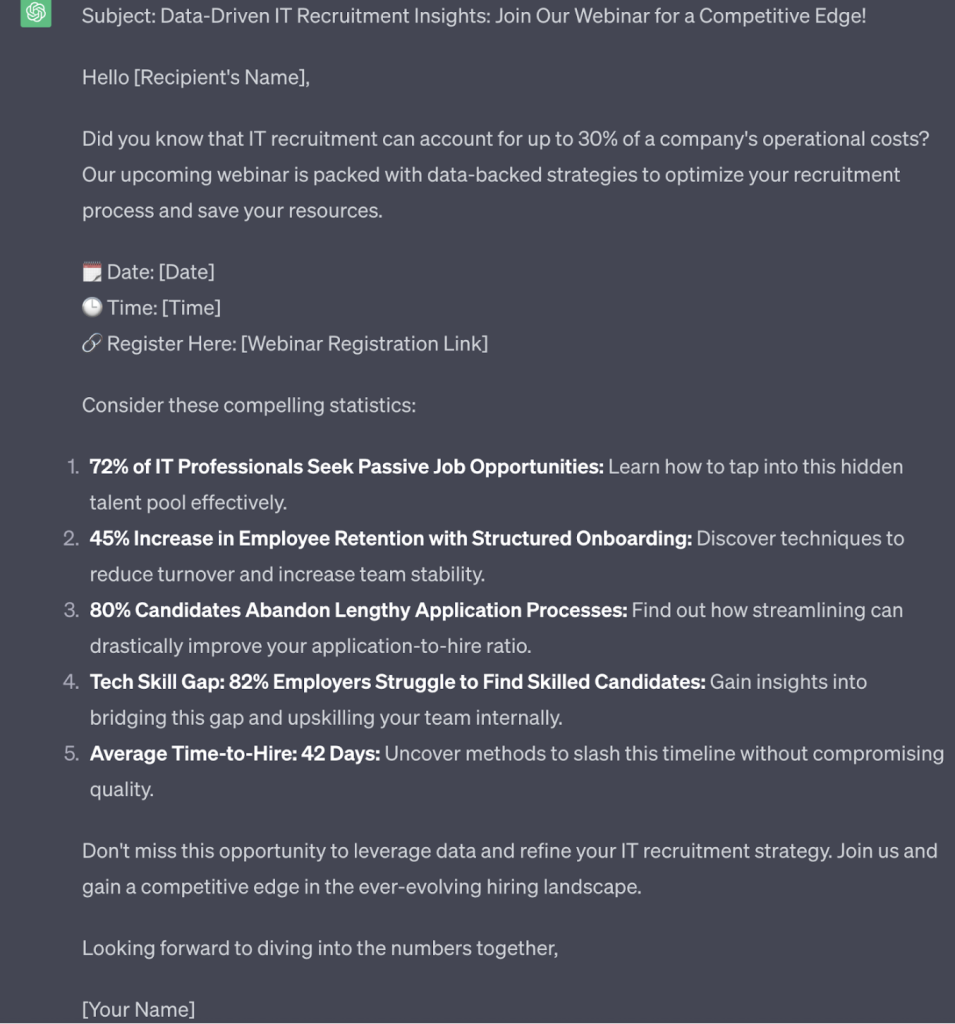
Speaking of numbers, doesn’t this look 100% more convincing than the original email? Of course it does. Dealing in specifics like this makes it that much easier for prospects to imagine the results they can get by continuing the conversation with you.
By the way, always try to verify the accuracy of any data you include in your emails through at least one other source. The same internet that is full of facts is also full of…other things.
Add mentions of current industry trends
It’s important to be seen as someone who keeps up with news and the latest trends in your profession. Referencing the world outside of your emails and how larger events are influencing you is always a good thing. Look at how I spiced up my original email with “add something about current trends”:
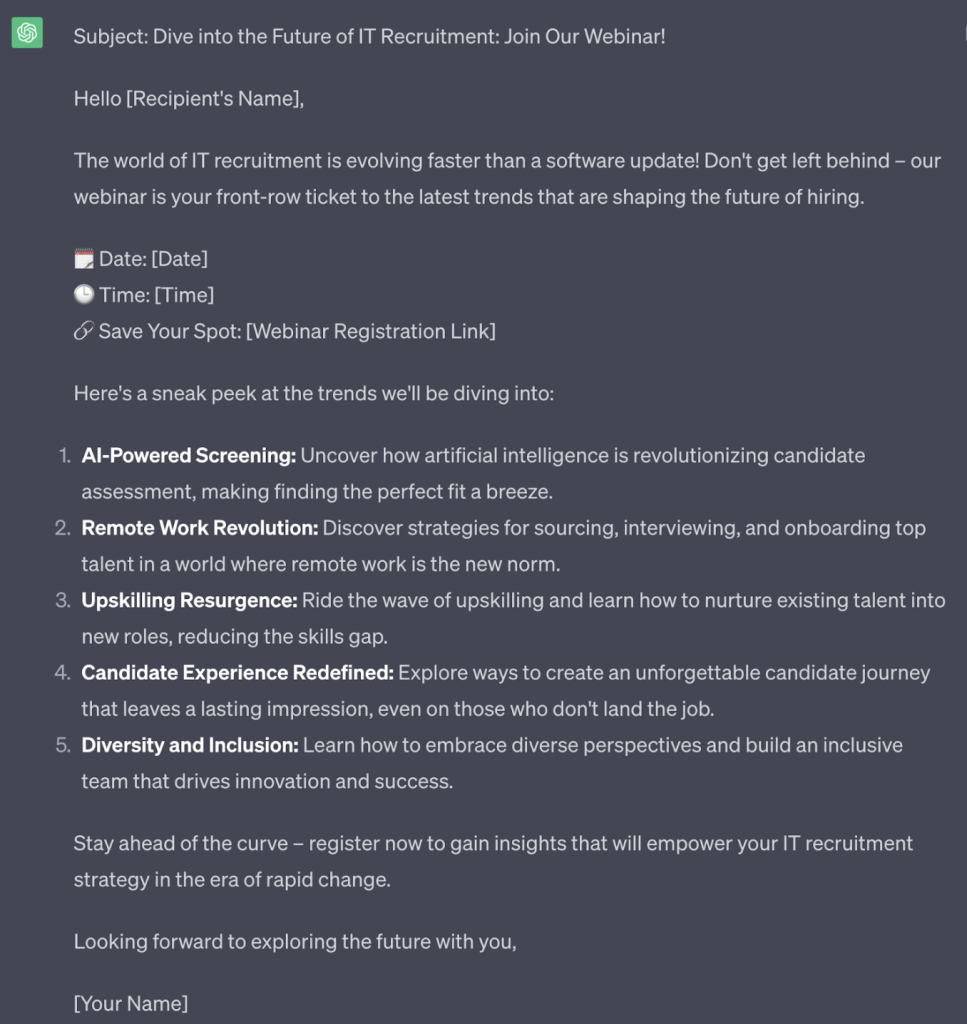
The addition of information about industry trends expands the scope of the mail and gives some extra importance to the whole idea of expanding your skill set. It also makes me, as the sender, look more informed about my world.
All of these variations and improvements on my original email are perfect illustrations of something I mentioned earlier — small changes in your prompt can result in big, impressive changes in the output you get from your AI tool.
Make it part of your routine to try at least a couple of these prompt changes on every cold email you compose. As you can see, simply adding two or three words at the end of your prompt can give you a text that is ten times better than what you already had.
That’s the power of the prompt!
Other tips and reminders for composing great cold emails with AI
Before we bring things to a close, let me share a few other random bits of advice for getting the most out of your cold emails with the help of AI platforms. These may not fit neatly into the categories above but they are worth remembering if you want to take full advantage of the help that AI can provide.
Use AI for your subject line
Although most AI tools suggest a subject line to go along with whatever email content they create, that doesn’t mean you’re stuck with what it gives you. Work on the subject line independently of the main text using any of the tips we’ve mentioned, like changing the tone, adding statistics, rewording, etc.
Remember that subject lines are a great place for A/B testing so get in the habit of creating multiple subject lines for every cold email.
Interestingly, you may find that general AI tools can give you better results than platforms that are specifically designed to generate email subject lines. Use different prompts until you unlock the winning combination!
Tell AI not to sound like AI
I prefer to leave the issue of whether or not AI knows that it’s AI to the philosophers. For marketing pros using cold emails, the more important question is “Can AI not sound like AI”? Based on my experience, I would definitely answer “Yes”.
This is important because, like I mentioned in the very first example above, AI often turns to cliches and very “safe” wording that is quickly becoming easily identifiable as AI-speak. It’s just a little too formal, a little too stiff and un-human enough to make some people notice.
Adding “don’t sound like AI” to your prompt can produce some interesting results.
Just as a quick illustration, I started with this:

And then I told the platform to write the same thing but “don’t sound like AI”. This is what I got:

This example is far too small to see a huge difference, but the difference is there. It’s more familiar, more relaxed and warmer. Not black-and-white different, but a good reminder that it’s worth telling AI not to sound like itself so you can get another version of your message to consider.
Remember that while these adjustments can help you generate different versions of your cold email, it’s important to review and edit the responses to ensure they align with your goals and resonate with your target audience. AI-generated content should always be polished and refined before sending.
Exclude certain elements
You can use AI to keep various things out of the cold emails you compose as well. Just make sure they don’t somehow sneak into your cold email, you can tell AI to exclude things like:
- “I / we” language that takes the focus away from the prospect
- Too-long sentences
- Marketing jargon or cliches
- A “salesy” tone
- Any other words or phrases that aren’t consistent with your tone, image, brand, etc.
Remember the dangers of not customizing AI-generated content
As I’ve mentioned before, it’s a mistake to just copy whatever your AI tool generates for you and paste it directly into the email you’re composing. You always want to add some personal touches, make a couple of small changes, substitute some adjectives and generally make it your own in some way.
If you don’t do this, you risk using the same text that someone somewhere is using in their email, which means you’re increasing the chances of attracting attention from sensitive spam filters. Once you get on their radar, you have a whole new set of problems to deal with.
Also, Google and other search engines are in the process of deciding what, if anything, to do with the flood of AI-generated text that is hitting the internet. Will you be somehow penalized for using AI text because it’s not original? This hasn’t been settled yet but it’s a good idea to get into the habit of testing your texts to see if you might be relying too much on AI.
Use tools like Copyleaks, Writer.com, Crossplag, Content at Scale, GPTZero or Originality.ai to get an “AI score” and learn if it might be time to mix things up a bit.
The last word — your cold email checklist
Let’s close with a quick checklist of the fundamentals that never go out of style. Always be on the lookout for ways to improve and optimize these elements of your next cold email campaign:
- Personalization. Every email you send needs to sound like it was composed for one person. You have the tools to do it and it’s today’s expected standard so
- Clear CTA. Every recipient should be clear on what you want them to do or how they should react to your email.
- Subject line. Maybe the most challenging part of all — you get just a handful of words to intrigue your recipient.
- Deliverability. Have you done everything possible to keep your message away from spam filters?
READ ALSO

10 Factors that Make Our Cold Emails Work (or Not)
If you're sending cold emails, you know that sometimes your messages work amazingly well, sometimes they work OK, and sometimes they don't work at all. And whether your outreach works great, or it hardly works at all, there's always a reason for that. Actually, in most cases, there's a whole collection of reasons for that. Here's a list of 10 factors that you may want to check to discover the cause of your campaign's success or failure, and to improve the effectiveness of your emails in general.
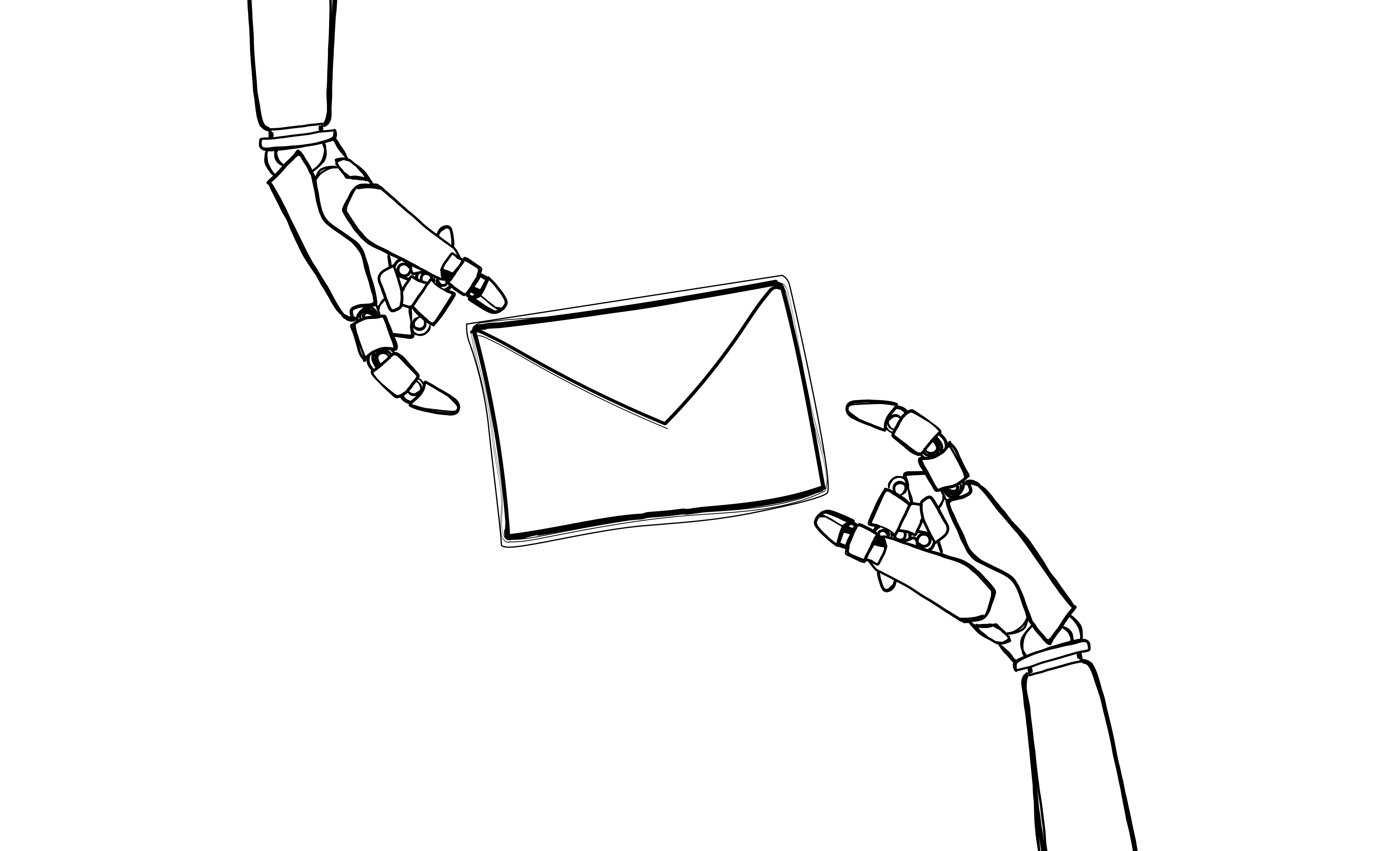
AI Guide for Writing Cold Emails: Part 1 – Frameworks
It’s no secret that AI text generation tools can get the job done faster than you can. And more creatively than you can. And with more detail than you can. And do it all in a hundred different ways you would probably never think of on your own.

Features vs. Benefits – How to Present Your Product in a Cold Email?
We’ve been talking with our users about the copy of their emails. It seems like they often struggle to tell the difference between the feature of their product, and the benefit this feature will bring to their potential client. Or rather, they feel like writing about features will automatically make the prospect think about benefits – just like they do when they write about their product. Well, the problem is the prospects, especially in outbound sales, often do not have that special ability to see the benefits while reading about features. That’s why it’s important we talk benefits instead of features when communicating with our potential customers. Here’s how to learn the difference between the features and benefits and how to write about benefits instead of features in your cold email pitch.

